Part of Singapore Biennale 2016, An Atlas of Mirrors presents contemporary artworks by more than 60 artists and art collectives from Southeast Asia, and East and South Asia.
"FROM WHERE WE ARE, HOW DO WE PICTURE THE WORLD AND OURSELVES?"
In charting our way around the world, humankind has relied on instruments of vision as well as navigation. Atlases map and mirror our journeys of discovery and often make visible more than just physical terrain; driven by our needs and desires, they embolden us to venture into the unknown.
"Singapore Biennale 2016, centred on Southeast Asia, investigates the intangible wells of identity and nationhood and other states of invisibility in the make-up of the region’s histories and cultures. Titled ‘An Atlas of Mirrors’, this Biennale’s vantage points are East Asia, South Asia, and Southeast Asia, and stellar artworks were selected or commissioned by an organising curatorial mind, working like a navigational tool that maps and mirrors regions within and around us. Artists from across Asia, from Bangladesh and Brunei, Cambodia and China, to Singapore and South Korea conjure visual worlds where the real, surreal, abstract and imaginary migrate and intertwine, and each communicates – from vastly different perspectives and national locations and by different media – similar yearnings. For something better, more humanity." JANE ITTOGI - Chair, Singapore Art Museum
"The fifth edition of the Singapore Biennale marks a decade-long journey of establishing itself as Singapore’s pre-eminent showcase of contemporary art. Today, the Biennale is a much-anticipated event that inspires meaningful dialogue and exchange of ideas between art communities in our region. We are happy that it has become a critical platform for the unique practices, concerns and perspectives of artists from Southeast Asia, and acts as a springboard for featured artists to be noticed and invited to other global platforms." KATHY LAI - CEO, National Arts Council, Singapore
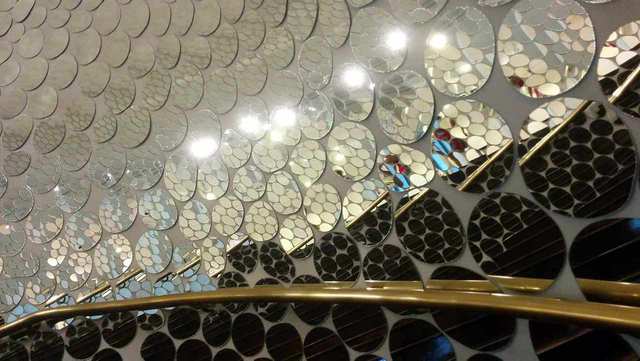
Paracosmos, 2016
Glass mirrors Site-specific installation, dimensions variable Collection of the Artist Singapore Biennale 2016 commission
HARUMI YUKUTAKE BORN 1966, TOKYO, JAPAN. LIVES AND WORKS IN TOKYO.
Paracosmos propels the viewer into a parallel world – a space of otherness that is recognisable but unfamiliar. Shaped by Shinto ideas of interconnectivity, the site-responsive work is situated in the circular stairwell of the Singapore Art Museum, a central transition space that connects two floors.
Here, the ‘membrane’ of hand-cut mirrors dissolves the definition between foreground and background by dissipating the single image into an explosion of reflections.
A space of simultaneity, and eternally liminal, the mirror was core to philosopher Michel Foucault’s concept of the heterotopia as a kind of zone that could encompass other sites.
Yet munificence can also be deceptive, and like a mirror that throws a warped or skewed reflection, heterotopias can disturb and distort the spaces held in their embrace.
The mirror reveals itself as a paradoxical device: able to hold every other image by having no inherent image, it can enfold an ‘everywhere’ by being a ‘nowhere’ in itself.
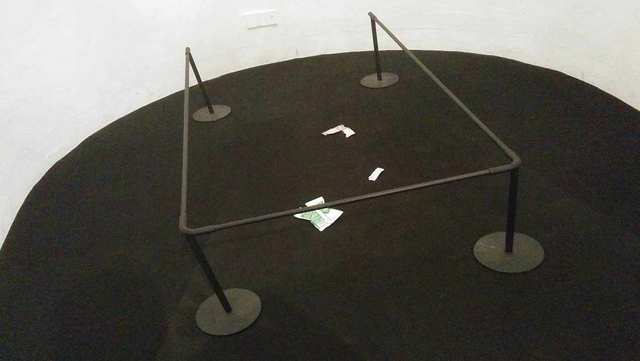
Rubbish, 2016
Colour pencil on paper (8 pieces) Various dimensions Collection of the Artist Singapore Biennale 2016 Commission
KENTARO HIROKI BORN 1976, OSAKA, JAPAN. LIVES AND WORKS IN BANGKOK, THAILAND.
Working with a strict methodology and set of criteria, Kentaro Hiroki handpicks everyday objects discarded on the streets to form the basis for his works. The things he chooses are intended to be reflective of time and space: unique to the localities in which he finds them, each object has its own story to tell of the communities it was found in.
Once the artist has painstakingly replicated each found article into a detailed paper reproduction of the original item, the original value of these items in the economic context is replaced with an art object, its uselessness imbued with renewed meaningfulness.
Each piece takes up to four days to create, and Hiroki’s execution is simultaneously an exercise in translation and self-reflection.
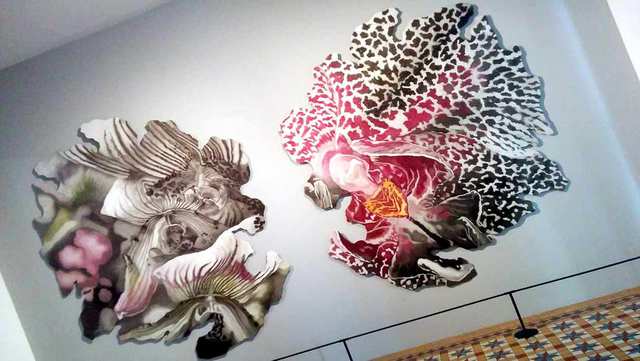
The Hunters Enter the Woods, 2016
Oil on aluminium 300 × 540 cm (installed width of diptych) Collection of the Artist Singapore Biennale 2016 commission
PATRICIA PEREZ EUSTAQUIO BORN 1977, CEBU, THE PHILIPPINES. LIVES AND WORKS IN MANILA, THE PHILIPPINES.
Rendered with hyper-realist precision, Eustaquio’s painting reflects on our contradictory attitude towards the world – both manmade and natural – through the metaphor of the Orchidaceae, asking what drives our quest for the unique, even as we seek to manipulate and replicate the object of our desire.
While orchids were once rare specimens that spurred an obsession in flower hunters, they are now big business in the global horticulture industry and popular attractions in botanical gardens, with over 100,000 hybrids created to date. The diptych – resembling Rorschach inkblots or island formations – mirrors the orchid’s zygomorphic form.
The left side portrays the Paphiopedilum fowler, an endangered wild orchid that can be found in the Singapore Botanic Gardens. The adjoining panel depicts a recently named orchid hybrid: as part of this artwork’s commissioning process, Eustaquio acquired its naming rights. “Winter Wedderburn” references a H.G. Wells story, in which an orchid collector is killed by his bloodsucking floral possession.
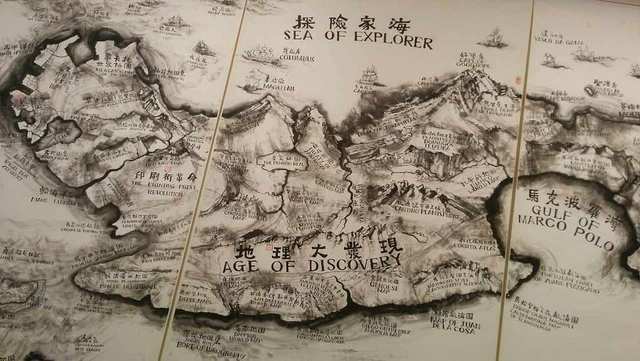
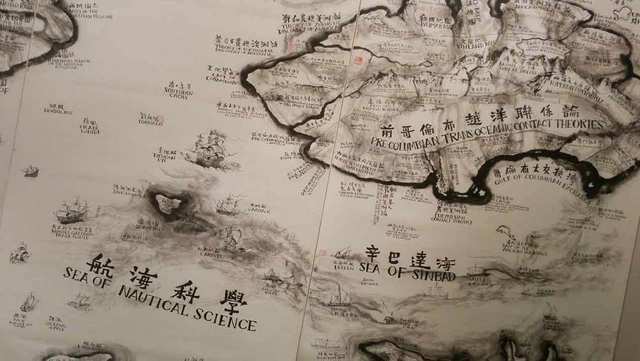
One Has to Wander through All the Outer Worlds to Reach the Innermost Shrine at the End, 2016
Ink on paper, glass and stone Dimensions variable Collection of the Artist Singapore Biennale 2016 commission
QIU ZHIJIE BORN 1969, FUJIAN, CHINA LIVES AND WORKS IN BEIJING AND HANGZHOU, CHINA
In his creation of maps, Qiu adopts a methodology that incorporates daily experience as well as a philosophical approach to thinking with graphics, and organising relationships and systems of knowledge. This map series presents Qiu’s investigation into cartographic history.
From his archaeological analysis of pre-Columbian trans-oceanic contact theories, to the systemisation of motives, logics and methods of different map-making approaches, he links together history, philosophy, mythology and science. In this work, the artist surfaces two elements underlying the connections between the phantom island, Utopia, and monsters: fear and temptation.
While early adventurers and explorers were drawn to distant mysterious lands, their voyages, as they recount, were often interrupted when they encountered uncanny creatures.
Qiu’s installation features a handblown glass bestiary of fantastical monsters, imagined as traversing between the mountains and the seas, conjuring a world of mystery that may once have been out there, but has now disappeared.
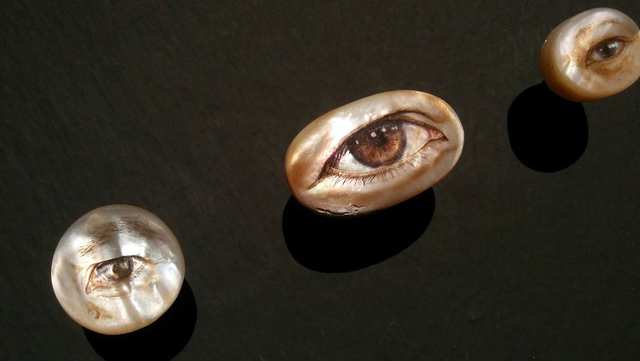
Karagatan (The Breadth of Oceans), 2016
Oil on mother-of-pearl shell and oil on pearl (set of 50) Diameter 2.54–5 cm (each); installation dimensions variable Collection of the Artist Singapore Biennale 2016 commission
GREGORY HALILI BORN 1975, MANILA, THE PHILIPPINES LIVES AND WORKS IN CAVITE, THE PHILIPPINES
Echoing the mystery of the mirror, this evocative installation does a poetic turn: in looking at the work, the work unnervingly looks back at you.
Karagatan portrays the eyes of residents in coastal villages across the Philippines, ranging from fishermen to pearl divers, a master boat-builder, shell traders and others.
The result of the artist’s research are delicate paintings that capture the tiny, distinctive characteristics of each subject’s eye: lines, curves and contours, which transform into unusual and unexpected portraits. As miniatures, the works draw upon a hallowed tradition associated with the royal courts, yet here, these tiny portraits map a community of coastal people who labour to harvest the bounty of the ocean but rarely reap its wealth.
Halili pays homage to people whose fates and fortunes are bound to the ocean, limning their likeness on precious mother-of-pearl gleaned from the deep.
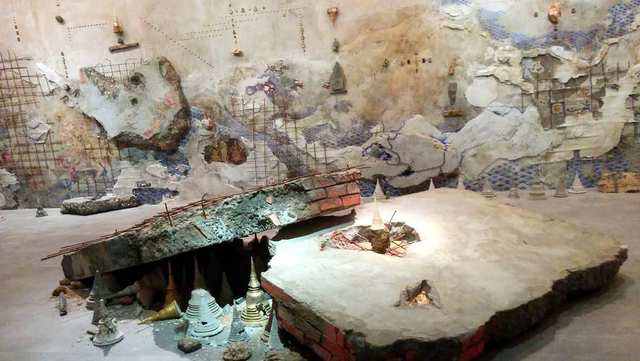
Aftermath, 2016
Mixed media: found objects, artist-made icons, concrete and paint Site-specific installation, 300 × 1600 cm Collection of the Artist Singapore Biennale 2016 commission
PANNAPHAN YODMANEE BORN 1988, NAKHON SI THAMMARAT, THAILAND LIVES AND WORKS IN BANGKOK, THAILAND
In a titanic mural, Pannaphan presents a mapping of the Buddhist cosmos that resembles a landscape painting. Using materials raw and natural, as well as the new and mass-produced, her amalgamation of contemporary and traditional Thai art creates a unified cartography of the heavens and the earth that chronicles Southeast Asian history.
Pannaphan’s ongoing investigation of the intersecting points between Buddhist cosmology and modern science has led her to consider the concepts of change, loss, devastation and inevitable armageddon.
The artist argues that our persistent striving for development and progress ultimately exposes our shortcomings and the revelation of a larger universe outside our spheres of comfort and control. She presents us with the ultimate question: at the end of all ends, will we find comfort in our faith?
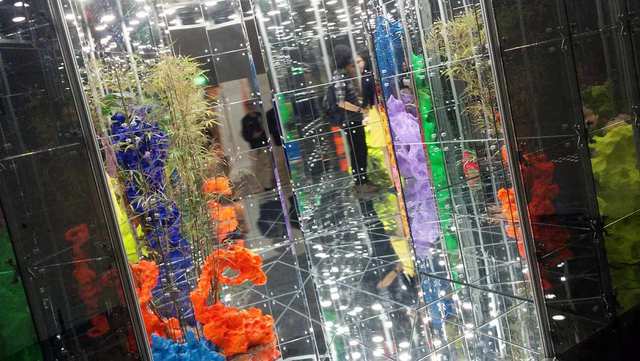
Noah’s Garden II, 2016
Aluminium alloy steel frame, mirror glass, LED lighting, real and artificial plants and rocks 1160 × 650 × 320 cm Collection of the Artist Singapore Biennale 2016 commission
DENG GUOYUAN BORN 1957, TIANJIN, CHINA LIVES AND WORKS IN TIANJIN, CHINA
This site-specific work is at once a garden of artificial flora and a labyrinth of mirrors. Entering the installation, viewers find themselves inside a kaleidoscope, where the surrounding infinite mirror images create a feeling of the loss of subjectivity.
Artificial plants, referencing classical Song Dynasty representations of particular flora, but coated in vibrant colours, assault the senses and blur the lines between the real and the artificial.
In applying the colour schemes from maps he has examined to these artificial plants and classically-referenced ‘scholar rocks’ he has created, the artist defies the conventional systems of colour-coding in map-making, recasting the world with a renewed hope for the integration of richness and diversity and the resolution of conflicts.
By evoking scepticism and uncertainty, his work raises doubt about the validity and accuracy of map-making; it creates a utopia while simultaneously disassembling it.
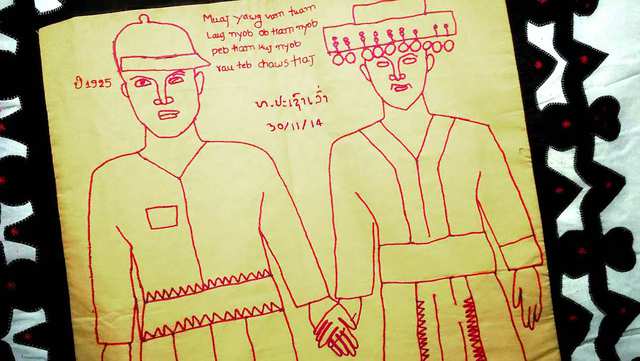

History, 2013–2015
Cotton fabric appliqué on cotton fabric (5 pieces) 118 × 107 cm (each) Collection of the Artist
PHASAO LAO BORN 1948, LAOS LIVES AND WORK IN LUANG PRABANG, LAOS
Lao and Siong are a husband-and-wife couple of Hmong ethnicity, who produce textile artworks that speak about universal concepts of genealogy, movement and migration, and symbolism and representation.
Lao’s History series is a rudimentary chronicle of his Hmong clan. Each panel includes a black border of motifs that symbolise ‘spirits’, and an outline of different ancestors or leaders in red, the colour of strength and courage.
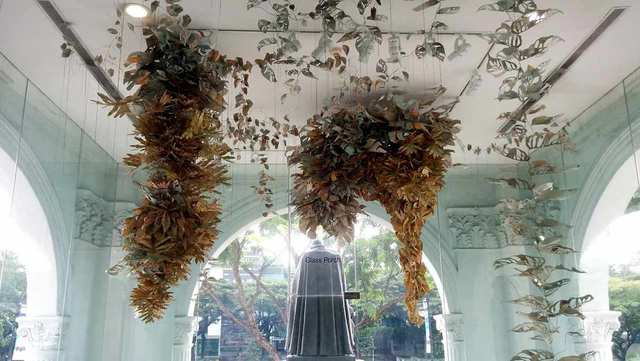
Locus Amoenus, 2016
Paper (replica maps) and felt Dimensions variable Collection of the Artist Singapore Biennale 2016 commission
RYAN VILLAMAEL BORN 1987, LAGUNA, THE PHILIPPINES LIVES AND WORKS IN QUEZON CITY, THE PHILIPPINES
Latin for a “pleasant place”, the phrase Locus Amoenus also evokes the notion of an escape into an ideal landscape. In this instance, the pastoral paradise has been sited within a house of glass – the greenhouse – an engineered Eden for flora uprooted from its native soil. Indeed, Villamael’s ‘greenhouse’ houses unusual foliage: intricate cut-outs created from archaic and contemporary Philippine maps.
Coalescing notions of nature and nurture, culture and the cultivated, the work probes the imaging of the Philippines’ fraught history as the country that endured the longest colonial rule in Southeast Asia.
Collapsing multiple realities, the installation is cut from maps that have two sides – a semiotic layering that conjoins the historical with the present-day. Creeping down from the ceiling, the Monstera deliciosa looks to colonise its climate-controlled space in the museum.
It is situated in the Singapore Art Museum in the only space where a section of the original colonial building façade from 1852 is still visible.
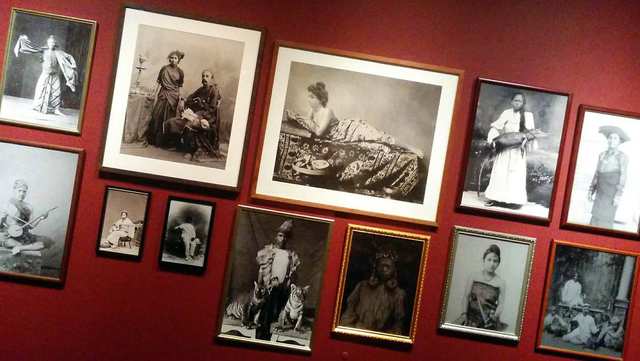
Mardijker Photo Studio, 2015
Installation with framed photographs (digital C print on paper) Various dimensions Collection of Axton Salim and the Artist
AGAN HARAHAP BORN 1980, JAKARTA, INDONESIA LIVES AND WORKS IN YOGYAKARTA, INDONESIA
Harahap reworks archival photographs to present fictive portraits of the Mardijkers, a community of descendants of freed slaves found in major cities in the East Indies (present-day Indonesia).
Comprising indigenous people from conquered Portuguese territories, as well as people of Portuguese ancestry, the Mardijkers occupied an in-between status: despite adopting European religion and culture, they were classed with the ‘natives’ by the colonial government.
The superimposition of European faces on ‘native’ bodies, and vice versa, captures the fluidity and instability of identities within this community, a situation which the artist views as analogous to contemporary Indonesia’s negotiation with ‘global’ culture. In this series of arresting and enigmatic portraits, some subjects appear to adopt foreign dress and ways of life confidently, while others reveal their uncertainty or hesitation.
These images also comment on colonial photography, which often eroticised its subjects, as well as our expectations of the photographic image as ‘truth’ and ‘document’.

The Name, 2008–ongoing
Video projection, books and musical score Dimensions variable Collection of the Artists
TUN WIN AUNG & WAH NU TUN WIN AUNG: BORN 1975, YWALUT, MYANMAR WAH NU: BORN 1977, YANGON, MYANMAR LIVE AND WORK IN YANGON, MYANMAR
The Name revisits established accounts of Myanmar’s past by intervening in its ideologically-driven gaps. The husband-and-wife artist duo have resurrected figures from the nineteenth-century Anglo-Burmese Wars and beyond, recuperating an autochthonous historical voice against what they perceive as a colonial narrative.
The three Anglo-Burmese Wars left the Burmese empire depleted; with each defeat, the Konbaung kings of Burma surrendered more territory to the British, until the final conflict concluded with the annexation of the country. In this work, portraits adorned with ornate, arabesque patterns emerge as uncanny apparitions, deliberately aestheticised and re-presented as majestic, almost monumental tributes.
The series includes photographic images of figures such as King Thibaw, U Wisara (a Buddhist monk who died after a six-month hunger strike against British rule in 1929, becoming an icon of the nascent independence movement) and Saya San (the leader of the so-called Saya San Rebellion in 1930–1932, a key event of the anti-colonialist crusade).
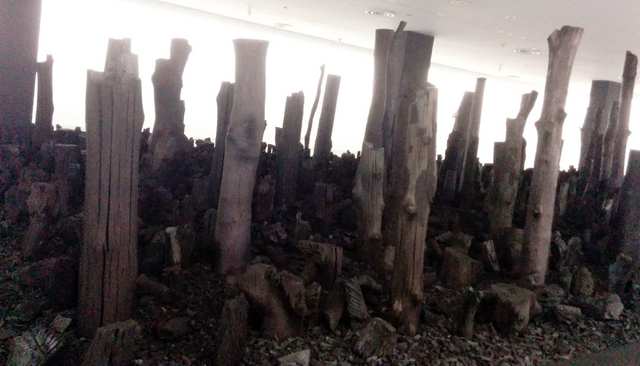
Black Forest 2016, 2016
Wood and charcoal Dimensions variable Collection of the Artist Singapore Biennale 2016 commission
HAN SAI POR BORN 1943, SINGAPORE LIVES AND WORKS IN SINGAPORE
Han has been recognized for her investigations into the impact of human activities on the natural world. Since 2011 she has been working on the ‘Black Forest’ series, which takes the form of installations comprising black or blackened wood logs lying on beds of charcoal.
This presentation is different: we see a destroyed ‘forest’ of charcoal logs standing upright. Representing the charred wood from ongoing deforestation activities, these evocative ‘columns of nature’ prick our conscience, yet attest to Nature’s resilience against every imaginable catastrophe.
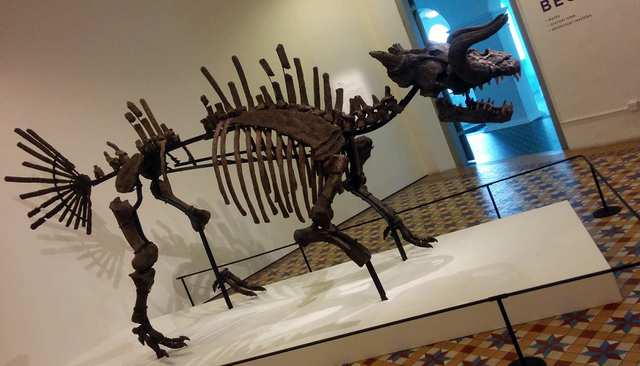
THE SKELETON OF MAKARA (THE MYTH OF A MYTH), 2016
Fibreglass and metal 220 × 425 × 115 cm Collection of the Artist Singapore Biennale 2016 commission
AN ZI HAO BORN 1989, KUALA LUMPUR, MALAYSIA LIVES AND WORKS IN SERDANG AND THE KLANG VALLEY, MALAYSIA
One of the most prevalent mythological icons in Southeast Asia is the makara, which originated in Hinduism. Depicted as a hybrid of different animals, typically half-mammal and half-fish, it has penetrated cultural, religious and philosophical discourses.
Based on the idea of conceiving a myth out of a myth, Tan fabricated a large-scale skeleton of a makara: an elephant-crocodile hybrid with the tusks of a wild boar and the tail of a fish. His intention is to provide a ‘scientific’ basis to myth through presenting paleontological ‘evidence’; the replica of a fossil is intentionally incomplete to make it more believable.
The artist shows how the dissemination of an icon such as the makara has influenced our historical narratives, and reveals how our construction or representation of history is sometimes based on something totally chimerical and imaginary, even absurd.
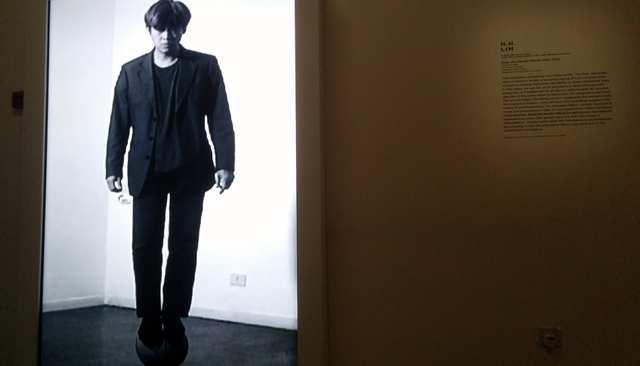
Enter the Parallel World, 2001, 2016
2-channel video Dimensions variable Collection of the Artist Singapore Biennale 2016 commission
H.H. LIM BORN 1954, KEDAH, MALAYSIA LIVES AND WORKS IN ROME, ITALY AND PENANG, MALAYSIA
This installation comprises two video works. The first, About 60 kilos of wisdom, recalls a favourite saying of Lim’s mother, that wisdom is nothing more than the ability to keep a balanced state.
In this video, we see the artist dressed in a dark-coloured suit, balancing on a basketball for an almost unbelievable 30 minutes (the title of the piece refers to how much Lim weighed at the time).
The second video, The falling wisdom, represents the moment when this balance is broken: Lim’s fall from the basketball suggests the reality of corporeal limits. The twinned videos – almost identical in scope and presentation – take on new significance within the theme of the Biennale.
Enter the Parallel World juxtaposes two diametrically opposed outcomes that quietly, slyly toy with the viewer’s expectations. Despite what seem like simultaneous performances, the actuality is that the process of failure was what led to the achievement of balance.

Desert Islands, 2009, 2016
Engraved mirrors, cardboard, aquarium and media player with sound Dimensions variable Collection of the Artists
MAP OFFICE ESTABLISHED 1996, HONG KONG LIVE AND WORK IN HONG KONG
Reflected from the surfaces of 100 engraved mirrors, each bearing an island and its coordinates, a familiar topographical seascape is fractured.
The 100 mirrored islands – carefully selected following research conducted by the artist duo MAP Office since 2008 – presents a collection of islands that, despite their overlooked status, have played significant roles in shaping the global consciousness, and have become a point of reference for global desires, as well as fears and secrets today.
Complementing this atlas, Domesticated Island stands as the 101st island in the work. A topographical approximation of Singapore’s geography, it provides seating under the shade of a fake palm tree, where audiences can listen to audio recordings or peruse reference materials.
Domesticated Island is also a vantage point from which to view the 100 islands.
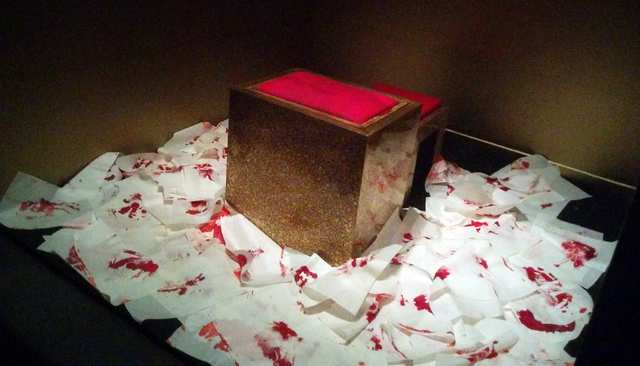
Behind the Light, 2016
Durational performance and installation Dimensions variable Collection of the Artist Singapore Biennale 2016 commission
MELATI SURYODARMO BORN 1969, SOLO, INDONESIA LIVES AND WORKS IN SOLO, INDONESIA
In literature and art, mirrors have been revered as instruments that reveal the truth or essential nature of things and beings, as a means of scrying or obliquely surveying, and as portals to parallel worlds.
In some Asian theatre traditions, the mirror room is considered a sacred space, where the actor dons his mask and gazes into the mirror to become one with the character he is portraying.
Behind the Light returns to the mirror an element of its magic, mystery and agency, by suggesting that behind its surface – which both receives and reflects our gaze – is another dimension beyond the everyday. It turns on the idea of ‘psychological mirroring’, where individuals form ideas about themselves by observing and learning from others, while simultaneously influencing others by projecting their selves and personalities.
Behind the Light proposes an exchange between the two sides of a mirror, illuminating the relationships between self, surface, society and the spiritual world.
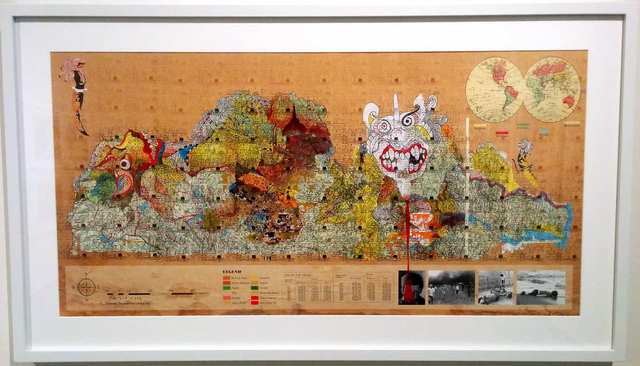
Other Map Series, 2016
Archival digital print, acrylic, ink, pencil on paper and canvas (20 pieces) Various dimensions Collection of the Artist Singapore Biennale 2016 commission
PALA POTHUPITIYE BORN 1972, DENIYAYA, SRI LANKA LIVES AND WORKS IN MULLEGAMA, SRI LANKA
Cartography is an act of history-making; history is created and interpreted by the act of mapping. Is it possible for an artist to look beyond officially constructed maps, and imagine a different past or an alternate future? Pothupitiye attempts to do so in this series, where he re-crafts the official version of maps to tell a different story.
The maps he constructs are like palimpsests where he overlays, juxtaposes and transforms portraits of voyages, landscapes, mythical figures and other maps to re-inscribe stories of Sri Lanka’s past and present, interspersed with his own personal history.
The maps he refers to range from Ptolemy’s maps of Ceylon to current maps of Sri Lanka. His atlas of maps tells many different stories simultaneously: of the deep scars of colonialism, the civil unrest and religious extremism of recent years, and also the lyrical beauty of a country that was once called Ceylon.
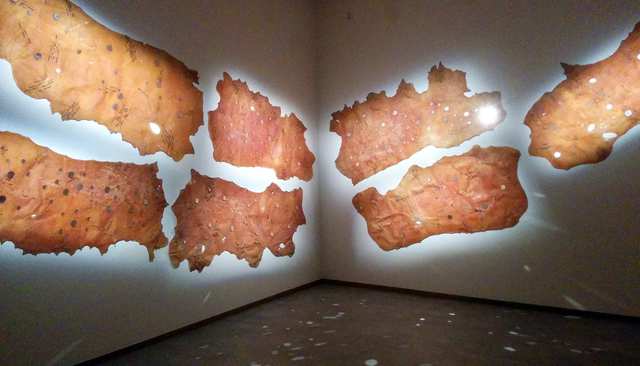
Treasure Islands, 2012
Raw buffalo leather, mirrors and nails Various dimensions Collection of the Artist
MADE WIANTA BORN 1949, BALI, INDONESIA LIVES AND WORKS IN BALI, INDONESIA
Treasure Islands delves into overlooked chapters of Indonesia’s colonial past, threading together geographies as disparate as the tiny spice island of Rhun in Maluku, Indonesia, and the metropolis of Manhattan in New York.
In the 1667 Treaty of Breda, the Netherlands relinquished their claims to New York (then known as New Amsterdam), in exchange for control of Rhun in the Indonesian archipelago, which was home to precious nutmeg trees, then regarded as the linchpin for Dutch control of the highly profitable spice trade.
Three and a half centuries later, the fortunes of these island outposts of empire have diverged dramatically, and Rhun has all but faded from global awareness.
Treasure Islands is inspired by a desire to recover these submerged historical relationships: the orange-gold surfaces of these skin-maps, embedded with glittering mirrors and nails, are redolent of the colour of the spices, yet evoke an arid and barren landscape, stripped of its treasures.
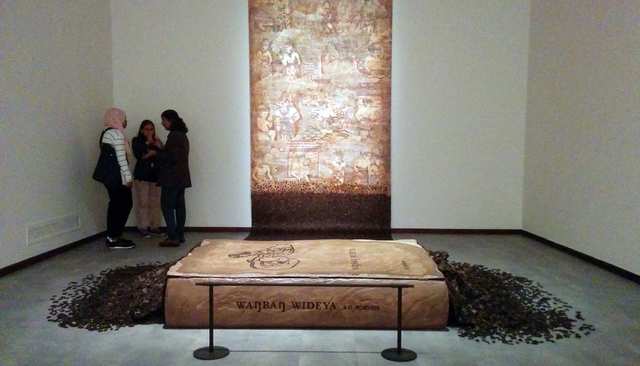
The Journey of Panji, 2016
Ink on canvas, acrylic and wood 300 x 500 x 300 cm Collection of the Artist Singapore Biennale 2016 commission
EDDY SUSANTO BORN 1975, JAKARTA, INDONESIA LIVES AND WORKS IN YOGYAKARTA, INDONESIA
The Panji cycle is a collection of stories revolving around the legendary Prince Panji, which originated in Java around the fourteenth century and spread to what is now modern-day Malaysia, Cambodia, Myanmar, the Philippines and Thailand. It was only in the last century that these stories were gathered into a single volume, the Wangling Wideya, by S.O. Robson.
The images in this artwork are taken from reliefs illustrating episodes from the Panji cycle. Their outlines are rendered in scripts, starting first with Javanese script, then flowing out into scripts reflecting the various regions and localities that this narrative has travelled to: a calligraphic cartography charting the movement of the Panji cycle throughout Southeast Asia.
Even as the work reminds us of Southeast Asia’s shared cultural histories, the letters spilling out from the compendium of Panji stories suggest the impossibility of ‘containing’ Southeast Asia and the limits of any attempt to unify its histories or to conceive of the region as a singular entity.
Find out more, including all other artists not included here, on the SAM website
You can also download the complete show brochure PDF